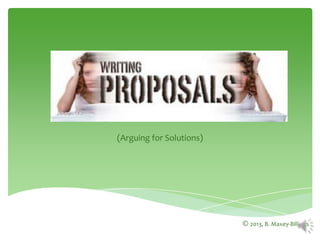
Media - writing proposals (1)
- 1. (Arguing for Solutions) © 2013, B. Maxey-Billings
- 2. The RFP (Request for Proposal) Many proposals respond to an RFP (Request for Proposal)—Such a “requested” proposal is called a “solicited” proposal. If you’re responding to a RFP, carefully review the details of the request. Provide all of the information specified in the RFP. Also, adhere to any design, length, or formatting details included in the request.
- 3. Unsolicited Proposals Of course, sometimes a proposal writer has identified a problem on his/her own. Such an “unsolicited” proposal must first argue that the identified problem exists, and then must propose an appropriate solution to it. For an unsolicited proposal, the writer must determine the design, formatting, and other elements.
- 4. Every effective proposal performs two common functions: 1. It identifies a problem. 2. It argues for (proposes) a solution.
- 5. And, all effective proposals consider the reader. • Remember that you’re writing the proposal to a reader who must approve it. • State the purpose clearly at the beginning of the proposal. • Arrange information so the reader can find it easily--a classical structure works well. • Provide background information that your reader may need in order to approve your proposal. • Make sure that the reader has all the information necessary to make a positive decision.
- 6. Eight Steps toward a Strong Proposal 1. For any solicited proposal,* follow the specific directions provided in the RFP. Use the format and sections the RFP specifies, and make sure you provide all of the requested information. * For the Proposal Assignment in ENG 3250, you’re producing a solicited proposal in response to my RFP, and you’ll use the example in your textbook as a model.
- 7. 2. In Plain English, define the “problem” and explain how your proposed “solution” will help to remedy it. Assure your reader that you understand the problem and can solve it effectively. NOTE: Every element of the proposal should address aspects of these two basic functions (that is, defining the problem and solving the problem).
- 8. 3. Assume that you must convince your reader that your proposed solution is the best. A proposal presents an argument. In it, you must argue to convince your reader of the two points mentioned earlier: • You’ve identified a valid and significant “problem.” • You’ve determined an effective way to address the problem. To argue effectively, avoid overconfidence. Don’t assume your reader will agree with you. Do your best to anticipate and address the reader’s possible concerns.
- 9. 4. Conduct any necessary background research. You can make a more convincing argument if you’ve investigated the issue. Provide the reader with examples, data, expert commentary, etc. that you’ve uncovered. Avoid arguing opinion. However, providing your reader with factual support can help you win the approval you seek for your proposal.
- 10. 5. Convince your reader that your solution will effectively address the problem. To argue for the effectiveness of your proposed solution, include an analysis of your plan and postulate about anticipated results. In other words, answer this question: What do you hope to accomplish by addressing the problem in the way you propose?
- 11. 6. Argue that your proposal is feasible. Provide timetables and deadlines to reassure your reader that you’ve considered the time, budget, personnel, materials, and any other components necessary to complete the project. Keep in mind that you’re asking the reader to approve your proposal and provide the necessary support, so make sure you explain why your proposal is worth the investment.
- 12. 7. Prepare a polished finished proposal. The quality of your proposal presents an ethos appeal. You want it to say to your reader, “This writer pays attention to details and can be trusted to carry out the proposed plan.” Thus, revise and proofread the content to make it as perfect as possible. Also, prepare an attractive and readable proposal. An attractive document helps make your argument for its approval.
- 13. 8. Include a clear, concise, and explicit “Call to Action.” After all, you cannot proceed with your plan until your reader approves your proposed project. Make sure you conclude your proposal with a CTA that asks for an approval of your proposed plan. CTA
- 14. After Approval Once you’ve gained approval for your proposal, the real work begins. So, make sure your proposal lays out a plan that you can actually carry out, and then stick with it. Good luck!
